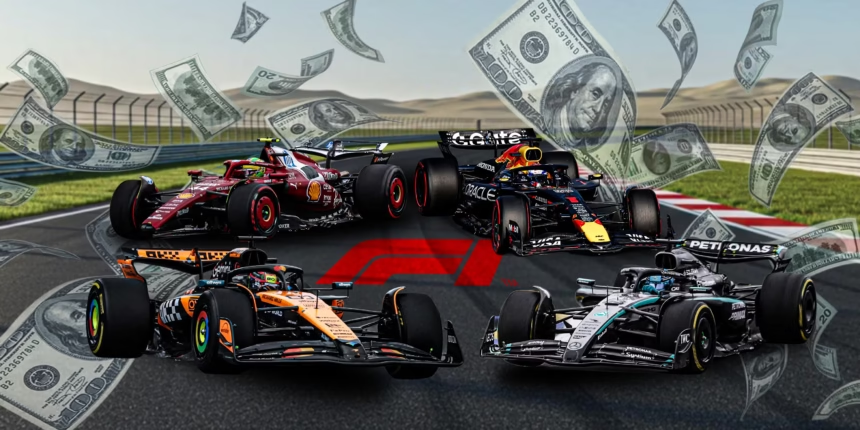The Billion-Dollar Grid: Ranking Formula 1’s Most Valuable Teams of 2025
Formula 1 (F1) has officially ascended to the pinnacle of global sports valuation, transforming from a high-stakes, capital-intensive pursuit into a lucrative, profit-generating enterprise. In 2025, the financial narrative of the paddock is dominated by staggering figures, driven by the seismic shifts introduced by the Cost Cap regulations and the exponential growth fueled by Liberty Media’s commercial strategy, notably the success of Drive to Survive and a focus on the US market.
The average valuation of an F1 team has skyrocketed to approximately $3.6 billion, a nearly 89% jump since 2023, placing the grid’s elite organizations in the same financial league as some of the most valuable franchises in the NFL and NBA. The total collective value of the ten teams now sits at roughly $34 billion. This comprehensive analysis dives deep into the financial metrics, brand equity, and strategic advantages that determine the hierarchy of F1’s most valuable teams in 2025.
The Formula for Value: Cost Cap and Scarcity
The unprecedented acceleration in F1 team valuations is not merely a reflection of better on-track performance; it is a structural economic phenomenon rooted in two key pillars of the sport’s current environment:
1. The Cost Cap: The Catalyst for Profitability
Implemented in 2021, the Cost Cap limits a team’s spending on areas related to the performance of its racecar (currently around $170 million for the 2025 season). .
- Financial Discipline: The cap forced the historically profligate top teams (Mercedes, Ferrari, Red Bull) to operate with financial discipline, turning what were often multi-million dollar annual losses into significant operating profits.
- Guaranteed Profitability: For new or prospective owners, the cap drastically reduces the risk of open-ended spending wars, offering a clearer pathway to guaranteed profitability. This certainty is highly attractive to institutional investors and private equity funds.
- Operating Profit Surge: Teams are now recording impressive operating profits. For instance, Mercedes recorded an estimated operating profit of $205 million in 2024, and Ferrari achieved $152 million. This profitability validates the Cost Cap model and drives valuation multiples higher.
2. Scarcity and Exclusivity: The Golden Ticket
There are only ten slots on the Formula 1 grid (with an eleventh, Cadillac, set to join next season). This scarcity of entry is the single most powerful driver of current valuations.
- Anti-Dilution Fee: The upcoming entry of Cadillac necessitated a $450 million anti-dilution fee to be distributed among the existing ten teams, demonstrating the tangible financial value of being an established franchise.
- High Barrier to Entry: The combination of the high entry fee and the immense logistical challenge of building a modern F1 team creates an almost insurmountable barrier, making the purchase of an existing team the only viable route. This has turned existing teams into scarce, highly desirable premium assets.
The Ranking: Formula 1’s Most Valuable Teams of 2025
Based on recent transactions, stake sales, and specialized financial reports, the valuations of the ten Formula 1 teams have been compiled. These figures represent the estimated total enterprise value, factoring in brand equity, historical performance, commercial agreements, and forward-looking profitability.
| Rank | Team | 2025 Estimated Valuation (USD) | 2024 Estimated Revenue (USD) | Primary Valuation Driver |
| 1 | Scuderia Ferrari | $6.4 Billion | $725 Million | Unparalleled Brand Equity and Heritage |
| 2 | Mercedes-AMG PETRONAS F1 Team | $5.88 Billion | $812 Million | Sporting Dominance and Corporate Integration |
| 3 | McLaren Racing | $4.73 Billion | $677 Million | Highest Growth Rate and On-Track Resurgence |
| 4 | Oracle Red Bull Racing | $4.32 Billion | $628 Million | Consistent Sporting Success and Engine Project |
| 5 | Aston Martin Aramco F1 Team | $3.0 Billion | N/A | Owner Commitment and Luxury Brand Synergy |
| 6 | Williams Racing | $2.14 Billion | N/A | Storied History and Turnaround Potential |
| 7 | BWT Alpine F1 Team | $2.08 Billion | N/A | Manufacturer Backing (Renault) and Stability |
| 8 | Racing Bulls (VCARB) | $2.05 Billion | N/A | Red Bull’s “Farm Team” Infrastructure |
| 9 | Stake F1 Team Kick Sauber | $1.88 Billion | N/A | Upcoming Audi Manufacturer Takeover in 2026 |
| 10 | Haas F1 Team | $1.68 Billion | $150 Million | Low-Cost Model and US Market Access |
Note: These figures are compiled from late 2025 financial reports and market estimates (e.g., Sportico, Forbes), and may vary slightly based on the methodology used.
The Apex Predators: Deconstructing the Top 4
The top four teams on the grid command a massive premium, driven by unique advantages that extend far beyond prize money and sponsorship income.
1. Scuderia Ferrari: The Unquestionable Icon ($6.4 Billion)
Ferrari consistently holds the title of F1’s most valuable team, a valuation that defies its recent lack of World Championship titles. Its valuation is rooted not in fleeting performance, but in unparalleled brand equity.
- Brand Premium (The “Aura”): Ferrari benefits from a massive brand premium that no other team can replicate. The racing team is inextricably linked to the globally recognized luxury car manufacturer and lifestyle brand. This linkage allows Ferrari to leverage the team for marketing, driving sales of its road cars, and commanding a higher sponsorship rate.
- The Hamilton Effect: The high-profile acquisition of seven-time World Champion Lewis Hamilton for the 2025 season created a massive surge in global exposure and commercial appeal, further cementing the brand’s cultural relevance and justifying the high valuation multiple.
- Unique Income Stream: As F1’s longest-serving and most successful team, Ferrari receives a unique and substantial historical bonus payment from F1’s prize fund, a testament to its contribution to the sport’s global identity.
2024 Financial Snapshot: Estimated Revenue: $725 million; Operating Profit: $152 million.
2. Mercedes-AMG PETRONAS F1 Team: The Corporate Powerhouse ($5.88 Billion)
Mercedes’ valuation is anchored by a decade of sporting dominance and its deep integration with the automotive giant, Mercedes-Benz.
- Corporate Synergy: The team operates as a crucial Technology Transfer and Global Marketing arm for the Mercedes-Benz brand, showcasing high-performance hybrid technology and reinforcing the AMG sub-brand. Its value is enhanced by the intellectual property it develops for its power unit division.
- Recent Transaction Validation: A major indicator of its staggering value was the recent sale of a minority stake by Team Principal Toto Wolff to billionaire George Kurtz. The transaction valued the entire team at approximately $6 billion, a 58% increase from just two years prior, and validates the market’s aggressive outlook.
- Revenue Leader: Mercedes typically leads the grid in terms of pure operating revenue, largely due to its immense portfolio of high-value blue-chip sponsors.
2024 Financial Snapshot: Estimated Revenue: $812 million (series-best); Operating Profit: $205 million (series-best).
3. McLaren Racing: The Resurgence Rocket ($4.73 Billion)
McLaren’s rise has been the most meteoric on the grid, with its valuation skyrocketing by over 200% in just two years. This dramatic jump reflects a powerful convergence of on-track success and astute financial management under CEO Zak Brown.
- Sporting Momentum: The team’s dramatic on-track resurgence, including multiple podiums and an anticipated Constructors’ Championship win in the 2024/2025 seasons, has massively amplified its visibility and commercial appeal.
- High-Value Stake Sales: A recent buyout of minority stakes by majority shareholders (Bahrain’s Mumtalakat and Abu Dhabi’s CYVN Holdings) valued the team at over £3 billion (approx. $3.65 billion USD at the time of the sale), giving it one of the highest valuation multiples in the sport.
- Diversified Portfolio: The valuation also reflects the value of McLaren Racing’s involvement in other high-profile series, including IndyCar and the upcoming WEC (World Endurance Championship) entry, diversifying its revenue streams beyond F1.
2024 Financial Snapshot: Estimated Revenue: $677 million; Operating Profit: $74 million.
4. Oracle Red Bull Racing: The Modern Dynasty ($4.32 Billion)
Despite being usurped in the championship standings by McLaren in the most recent season, Red Bull Racing remains a giant, valued for its consistent modern success and its commitment to becoming a true manufacturer.
- Success Premium: The team’s value is built on a legacy of championships with drivers like Sebastian Vettel and Max Verstappen. This success attracts top-tier global sponsors, evidenced by its title partnership with Oracle.
- Red Bull Powertrains: The ambitious creation of Red Bull Powertrains (RBPT), the in-house engine division for the upcoming 2026 regulations, fundamentally alters the team’s economic structure. This massive Intellectual Property (IP) investment transforms Red Bull from a customer team into a genuine manufacturer, justifying a significant increase in enterprise value.
- Global Media Brand: The team is an extension of the broader Red Bull media and energy drink empire, leveraging extreme sports and global events to drive sales and create a high-octane brand synergy.
2024 Financial Snapshot: Estimated Revenue: $628 million; Operating Profit: $27 million (Lower profit due to high R&D investment in the RBPT engine project).
The Mid-Field Millionaires: Teams Poised for Growth
The teams in the mid-to-lower end of the valuation table are no longer the financial liabilities of the past. They represent immense turnaround potential and are highly attractive targets for new investment due to their low entry points relative to the top four.
Aston Martin Aramco F1 Team ($3.0 Billion)
Aston Martin’s valuation is driven primarily by the ambition and massive capital injection of owner Lawrence Stroll.
- Luxury Brand Synergy: Like Ferrari, the team benefits from the halo effect of its associated luxury road car company, but with a renewed focus on electric vehicles and performance.
- Capital Commitment: The ongoing investment in a state-of-the-art new factory and the aggressive pursuit of top talent signals a long-term commitment to reaching the top, which financial markets value highly. The team has successfully attracted external institutional investors, such as Arctos Partners.
Williams Racing ($2.14 Billion)
Williams is the quintessential heritage brand currently undergoing a major financial turnaround under its new owners, Dorilton Capital.
- Storied History: Its valuation includes a significant premium for its historical success, holding the third-most Constructors’ Championships in F1 history.
- Clean Slate: Having shed the financial distress of its previous ownership, Williams now operates with financial stability and clear growth targets, making its IP and historical data a valuable commodity.
Stake F1 Team Kick Sauber ($1.88 Billion)
Sauber’s relatively high valuation, despite its current on-track performance, is entirely forward-looking and contingent on its 2026 takeover.
- Audi Manufacturer Entry: The team is set to become the official Audi works team for the new 2026 technical regulations. The promise of a full manufacturer backing—with the massive R&D budget, marketing synergy, and long-term stability that entails—makes the team a strategic entry point into F1 for a global automotive giant. This strategic value is why its valuation is already near the $2 billion mark.
The Financial Metrics: Why F1 Teams Are Now Hot Assets
The current financial boom is fundamentally different from previous F1 cycles. The teams are now being valued more like technology companies or global media platforms rather than traditional racing outfits.
Valuation Multiples and Cash Flow
- High Revenue Multiples: F1 teams are commanding high valuation multiples (Valuation/Revenue) precisely because of the cost cap’s effect on profitability. An asset with a guaranteed revenue share (F1 prize money) and a cap on variable operating costs is a textbook example of a desirable financial investment.
- Low Operating Risk: The Concorde Agreement—F1’s governing contract—guarantees a slice of the sport’s central revenue (from TV rights, sponsorship, and race fees) to all ten teams. This contractual revenue floor provides an extremely stable cash flow, mitigating commercial risk and making the teams highly attractive in corporate finance and merger & acquisition circles.
Source of Revenue: Beyond the Track
Team revenue streams are more diversified than ever, moving beyond on-track performance:
- Sponsorship (Approx. 40%): Driven by the global reach of the sport, particularly in the US and Asia.
- F1 Prize Money (Approx. 35%): The annual distribution based on the team’s position in the Constructors’ Championship.
- Ancillary/Technology (Approx. 25%): Income from non-F1 activities, such as engineering consultancy (e.g., Red Bull Advanced Technologies, Williams Advanced Engineering), merchandise sales, and simulator technology licensing.
The combined effect of regulated spending and increasing, diversified revenue has created a robust financial model, justifying the valuation of even the grid’s smallest team, Haas, at a remarkable $1.68 billion.











